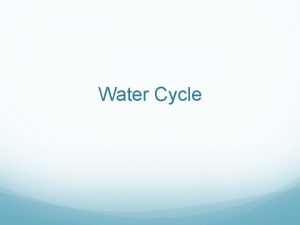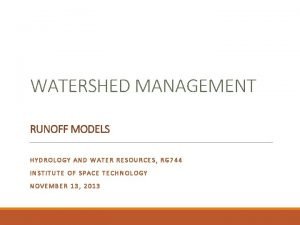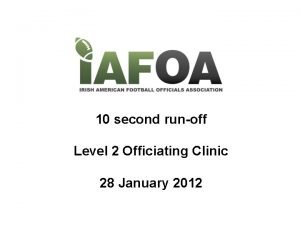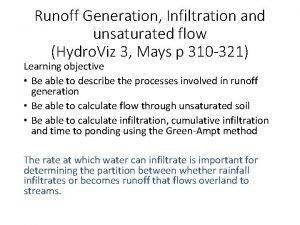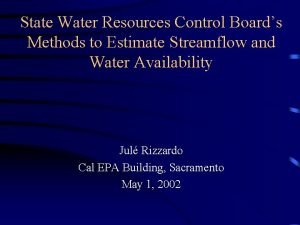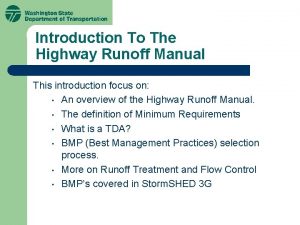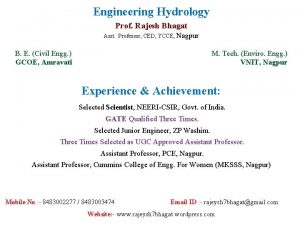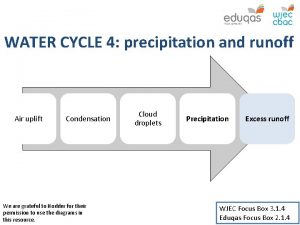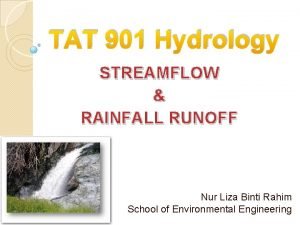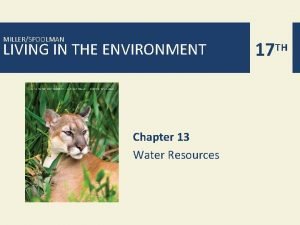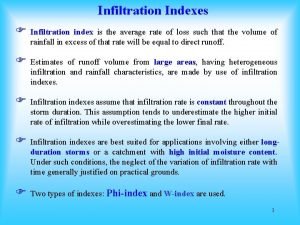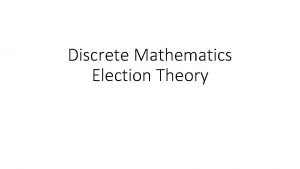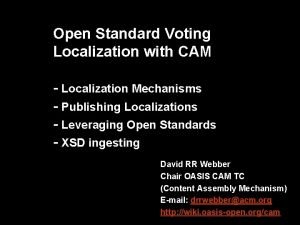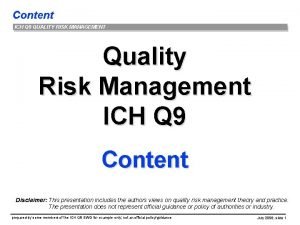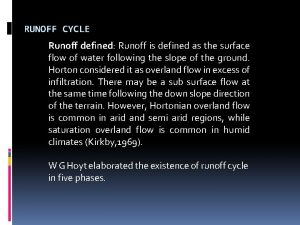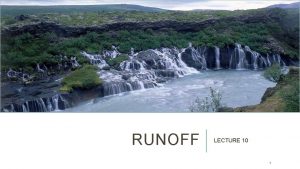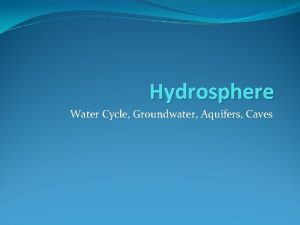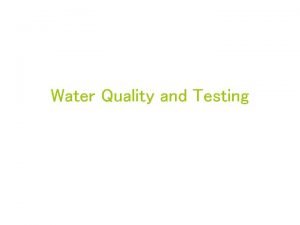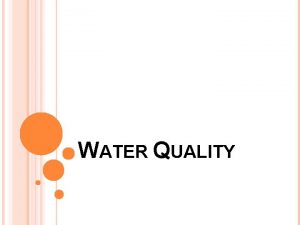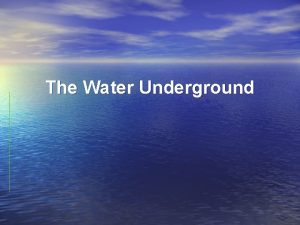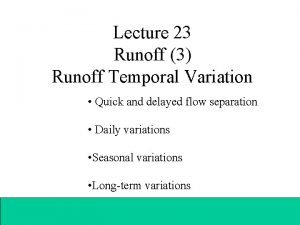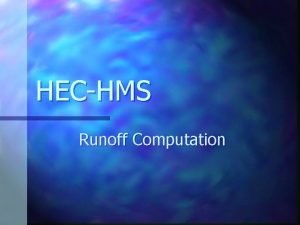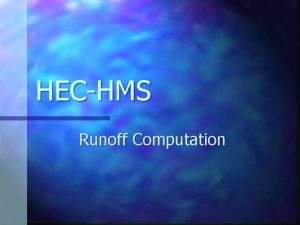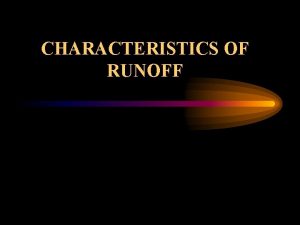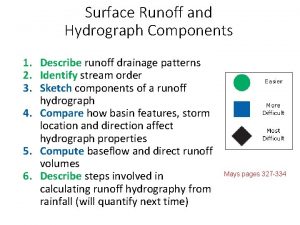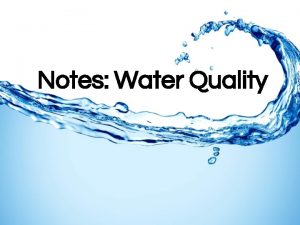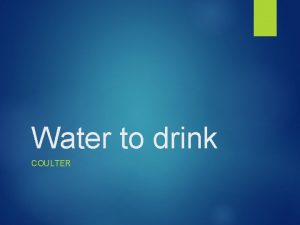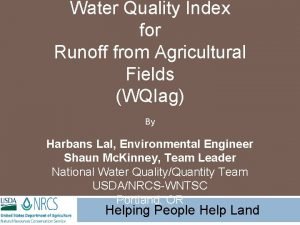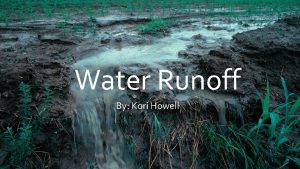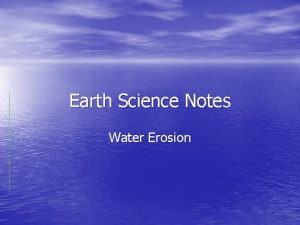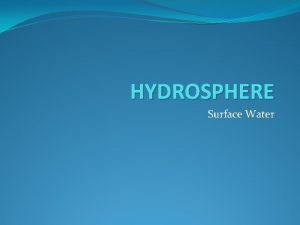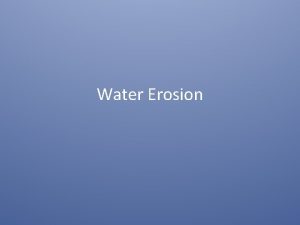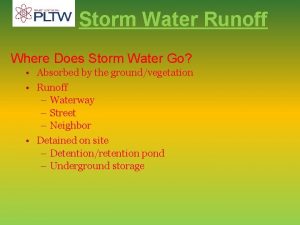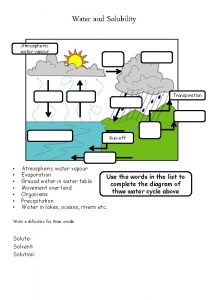What is the Risk to Runoff Water Quality





































































- Slides: 69

What is the Risk to Runoff Water Quality Posed by Fertilization of Turfgrass? Dr. Chris Murray, Department of Interdisciplinary Studies

Outline n What motivated this project? n Runoff and pollution n Turfgrass as a water quality management tool n Experiments and studies of the effect of fertilization n Conclusions

Project motivation A collaboration between Landscape Ontario’s Lawn Care Commodity Group and Lakehead University n Two factors initiated this project: 1. Source water protection agencies and similar organizations are considering fertilizer bans as a means of protecting water quality 2. Several studies had reported results contradicting this approach: where fertilizer is stopped, N, P in runoff increases n

General research questions n What is the true state of scientific information regarding this issue? n Is there consensus within the scientific community? n If so, does it support a ban on fertilization of turfgrass? n A primary focus of this study is the effect, both positive and detrimental, fertilization of turfgrass may have on the nutrient pollution through runoff.

Stormwater / runoff n Most critical to understand: what dominates water pollution n Why is runoff a problem? n Runoff is “natural”, and would exist without human intervention n Human activity dramatically increases runoff and the pollution it carries. n As runoff increases, pollution increases


Algal Blooms, Eutrophication

Terminology n Surface water/stormwater/runoff n Infiltration/leachate n In general, we aim to increase infiltration and decrease runoff to decrease pollution n Why? n Sediment and associated chemical pollutants

Erosion n Wherever development occurs, risk of increased runoff velocity and erosion n More sediment is carried into water

Dissolved/particulate pollution n Nutrients such as phosphorous are soluble in water, but will bind with minerals in sediment n A very small concentration of sediment may be responsible for most of the nutrient loading n For a given mass, fine particles carry more pollution than large particles, and carry it further

How can adding fertilizer help? Turfgrass is, in general, a non-native groundcover that requires maintenance to thrive n Without human intervention, it will not outcompete indigenous plants (weeds) which are better-suited to harsh conditions (especially drought) but not suited to humanscale runoff n In general, healthier turfgrass increasingly reduces runoff and increases infiltration/evapotranspiration n Runoff can be completely eliminated by turfgrass, and a lawn is often the only barrier between impervious surfaces and waterways n

Runoff, Infiltration and Erosion Control • • How might reducing fertilizer increase the concentration of N, P in water? Small effect: increased decay of plants Large effect: less healthy turfgrass cannot hold water as effectively, so runoff increases Filtering is not enough: the amount of water must be reduced


Competing Factors The contamination of runoff by nutrients (both dissolved and particulate) found in fertilizer contributes to eutrophication of lakes causing negative impacts on the aquatic flora and fauna. • Healthier turfgrass systems improve surface water quality through natural filtration and absorption of water, which reduces runoff intensity. •

Reports worth examining n Garn, 2002: n Kussow, 2002, 2004, 2008: – No runoff other than that due to rain on lawns – Increase P in runoff for fertilized lawns – The site with the best turf stand had the least runoff, though quantitative measurements not made. – No effect of fertilization on nitrogen in runoff – – Fertilization with P leads to more P in runoff Accounted for runoff volume Most (runoff, nutrients) recorded when soil frozen Without fertilization for two years, runoff, nitrogen and phosphorous increased – Whether soil is frozen is dominating factor

n Easton and Petrovic, 2004 – Examined both synthetic and organic fertilizer – P losses higher from P-containing fertilizer, highest for organic types (P applied very high) – Fertilization increased infiltration, decreased runoff – Frozen soil runoff accounted for majority – Fertilization during establishment created most pollution – In many cases, equal or higher N, P losses from unfertilized control due to overall increased runoff

n Beirman et al. , 2010 – Examined no fertilization, P-free, P and triple. P fertilization – Runoff highest for non-fertilized plots – P in runoff from non-fertilized site highest in year 1, the same as from site receiving P in fertilizer in subsequent four years – Frozen soil runoff dominates P loading, and recommended that no P used in Fall where runoff potential is high

Overview No studies perfectly controlled, perfectly realistic, but… n Usually, nutrient concentrations in runoff higher where fertilization is applied n Usually, amount of runoff is lower where fertilization is applied n Most often, the total nutrient loss in runoff is decreased by fertilizing n Where applicable, nutrient loss when ground is frozen dominates annual pollution n

For more information contact: Dr. Christopher Murray Department of Interdisciplinary Studies Lakehead University cmurray 1@lakeheadu. ca

In many of societies, turf (grass) has received an undeserved black eye with respect to H 2 O

Finding Balance Lawns and Water Conservation 1 acre of trees produces enough oxygen for 18 people 1 acre of grass produces enough oxygen for 64 people 1 acre of rocks produces enough oxygen for 0 people

Water conservation is a serious issue Benefits of Turfgrass Recreational v v v Low cost surfaces Physical health Mental health Safety cushion Spectator environment Functional v v v Soil erosion control Dust prevention Rain water entrapment Heat dissipation Glare reduction Pollutant entrapment Pest reduction Fire prevention Security Environmental protection Carbon Sequestering Aesthetic v v v v Beauty Quality of life Mental health Social harmony Community pride Increased property values Complements trees and shrubs in landscape

The Scope of Water Problems n Water shortages and water-quality issues are global n There is a need to both conserve and clean the world’s water supplies n Solutions need to be based on long-term, site-specific consideration

The Scope of Water Problems n Water shortages don’t n 30% water loss n Weather plays a role n Environmental n Regulation Plays a role n Pollution only happen in lowrainfall or developing countries due to aging Mechanical and structural issues allocations

The Earth is 71 % Water and 29% Land “Water, water everywhere, And all the boards did shrink; Water, water everywhere, Nor any drop to drink. ” --Samuel Taylor Coleridge (1772 -1834), “The Rime of the Ancient Mariner”

The Hydrologic Cycle n Amount of water has remained relatively stable for eons n We cannot increase water supply – we can only recycle it

Who Directly Consumes Highest % of Water? n Cooling for thermoelectric generation & production agriculture n Domestic uses target n Greatest savings publicly supplied water should come from greatest users

Different ideas of landscape and landscape maintenance which uses more water…

How much water does your lawn use? Mallard* Solar Green* *after 27 days with no water applied Albany, OR 2008 10, 000 GALLON WATER TANK Mallard required 8, 800 gallons of water to maintain a 5, 000 square foot lawn over the entire summer (90 days). Solar Green required 19, 700 gallons of water to maintain the same area; using nearly two of these tanks over the same time period!

Kentucky Bluegrass 50 Days With No Water Mallard – 38% Green Cover Created by Geronimo – 2% Green Cover

TWCA® Turfgrass Water Conservation Alliance® is an avenue to test and qualify turfgrass cultivars for improved drought tolerance.

TWCA Ø Non-profit organization Ø Based on an accepted protocol (PST, NTEP, AR) Ø Utilized since 2002 Ø Includes four grass seed companies – each participant develops their own brand Ø Has access to 8 rain out structures (OR (3), AR, VA, IN, NC, & newest addition Univ. of Guelph fall 2013) Ø Field testing in arid environments possible (OR, UC Riverside, CA, So NJ & possibly Olds College, Alberta, Canada)

PROTOCOL Ø Minimum testing = 2 location/years Ø Finish in the top statistical group with Digital Imagery Analysis (DIA) data collections Ø Acceptable measure of turf quality Ø Comprise a minimum of 60% in blends or mixtures Ø 3 rd party peer review of cultivars Ø More information available at www. tgwca. org

ØDrought Evaluation v Rain Out Shelters – v. Oregon / Arkansas / Virginia / Indiana / North Carolina / Ontario, Canada (fall ‘ 13) v Field Studies – v. Univ CA Riverside v. Olds College – in cooperation with Guelph v. Utah State – future location v Rain Out Shelter at Nex. Gen v. Field vs. Greenhouse Comparison Created by

RAIN OUT SHELTER (ROS) Created by

A new planting established

Ø Digital Image Analysis (DIA) u. Types of Analysis è Color è Cover è Turf Quality u Application è Drought è Disease è Wear è Color

Quality Ratings - Subjective 6. 0 7. 0 § 5. 0 Relatively poor correlations exist among researchers (r < 0. 68) (Skogley and Sawyer, 1992) (Horst et al. , 1984) Created by U of A

Quality Ratings - Subjective 6. 0 7. 0 5. 0 § Relatively poor correlations exist among researchers (r < 0. 68) (Skogley and Sawyer, 1992) (Horst et al. , 1984) Created by U of A

Light box and digital camera ease of use

Evaluations n Visual quality ratings (bi-weekly) – (1 -9 with 9 = optimal turfgrass quality, 6 = acceptable turf) n Cover analysis using digital images (weekly) (Richardson et al. 2001) 99. 2% green turf cover 28. 6% green turf cover

Density Analysis Shadow count Created by U of A (Karcher et al. , unpublished)

Digital Image Analysis (DIA) 1. 2. 3. 4. 5. 6. 7. Created by U of A Objective vs. Subjective Utilizes 1 to 9 scale 4 Parameters with 1 Evaluation Repeatable Calculate overall turf quality Requires minimal expertise Permanent record on file

Kentucky Bluegrass Data

Water Usage Comparison by Species Average 08/09

Assuming a 5, 000 square foot lawn, this chart shows the amount of water required to maintain 40% green cover at 90 days in Albany, Oregon. (08/09)

Role of TWCA q. Mission Statement SAn avenue to research and qualify turfgrasses that exhibit superior drought responses and provide education regarding water conservation.

Complexity of Drought Research v. Evaporation - ØWater movement from the liquid to the gaseous state. In reference to turf, it normally refers from the soil to the atmosphere. v. Transpiration - ØWater lost as it moves from the liquid to the gaseous state through the plant into the atmosphere. v. Evapotranspiration - ØThe total movement of water from liquid to the gaseous state, which includes the totality of the plant and the soil.

Help from Friends q. Earthworms q. Nematodes q. Mycorrhizae fungi – phosphorous uptake q. Azospirillum bacteria – brasilense amplifies effect of Arbuscular Mycorrhizae q. Agrobacterium radiobacter – phosphorus solubilizing bacteria

How can you help? Saving up to 50% water to keep the green Possible to use less fertilizer to keep the green Possible to use less chemicals to keep the green

Finding Balance Lawns and Water Conservation

THE TWCA IS COMMITTED TO WATER CONSERVATION

Questions? Russ Nicholson, CPAg, CCA russ@penningtonseed. com russ@tgwca. org www. tgwca. org

Natural Knit® Spreading Perennial Ryegrass vs. “Regenerating Perennial Ryegrass” trial data. Planting Date: 9/4/2010. • Seeding Rate: Natural Knit: 3 lbs/1000 ft. 2, vs “Regenerating” ryegrass: 7 lbs/1000 ft. ² (advertised recommended seeding rate). • Mowing height throughout trial: 2. 5 cm. • Nitrogen application: 4 lbs/ year. • On 8/6/2012, three replications of four inch diameter turf samples were removed from each test plot using a golf cup cutter. • Live tillers for each sample were then counted, averaged and extrapolated to live tillers per square foot of turf area.

LIVE TILLERS PER SQ FT OF TURF AREA Product Replication 1 Replication 2 Replication 3 Average Natural Knit® 9, 631 9, 699 9, 527 9, 619 “Regenerating” ryegrass 3, 153 3, 199 3, 222 3, 191

Planting Date: 9/4/2010. • Seeding Rate: Natural Knit: 3 lbs/1000 ft. 2, other “regenerating” ryegrass: 7 lbs/1000 ft. ² (advertised recommended seeding rate). • Mowing height throughout trial: 2. 5 cm. • Nitrogen application: 4 lbs/ year. • On 3/30/2011, four plugs of turf were removed from one plot each of product tested. • Each plug was then planted into the fallow border area next to demonstration plots to allow for standardized mowing and fertilizing throughout the year. • On 8/6/2012, the diameter of each plug was measured in two directions after being trimmed around the outside edge to remove any vegetative material that was not rooted. • The diameter measurements (widest and narrowest points) from each trimmed plot were averaged and used to calculate total area in cm².

Product Rep. # Transfer Date Beginning Diameter Beginni ng Area cm 2 Mowing Height N rate Trial Measure Date 16 – month Average Diameter Natural Knit® 1 2 3 4 3/30/2011 4. 5 cm 15. 9 cm 2 2. 5 cm 4 lb 8/06/2012 31 cm 733 cm² 4, 610% 4. 5 cm 15. 9 cm 2 2. 5 cm 4 lb 8/06/2012 30 cm 707 cm² 4, 450% 4. 5 cm 15. 9 cm 2 2. 5 cm 4 lb 8/06/2012 35 cm 962 cm² 6, 050% 4. 5 cm 15. 9 cm 2 2. 5 cm 4 lb 8/06/2012 30 cm 707 cm² 4, 450% 15. 9 cm 2 Avg. 31. 5 cm 1 2 Avg. 3/30/2011 16 -month Percent Increase in Unit Area “Regenerating ” Area cm² 777 cm² 4, 890% 4. 5 cm 15. 9 cm 2 2. 5 cm 4 lb 8/06/2012 21 cm 336 cm² 2, 110% 4. 5 cm 15. 9 cm 2 2. 5 cm 4 lb 8/06/2012 24 cm 460 cm² 2, 890% 15. 9 cm 2 2. 5 cm 4 lb 8/06/2012 25 cm 472 cm² 2, 970% 3 3/30/2011 4. 5 cm 4 3/30/2011 4. 5 cm 15. 9 cm 2 23. 75 cm 435 cm² 2, 740%

RTF SODDED OCT. 2011 U OF TORONTO, SCARBOROUGH CAMPUS SEPT 2012

AUGUST 2012

Serendipity HLM Nonirrigated HLM Irrigated

Grub assessment Cup changer • 6 plugs per 2 x 2 m plot • Taken in November Visual assessment of digging • Visual rating • Taken in November

Visual Damage 60 50 % visual damage 40 30 20 VISUAL DAMAGE 10 0 HLM Irrigated RTF Irrigated RPR Irrigated HLM Non-irrigated RTF Non-irrigated RPR Non-rrrigated

No. of grubs/0. 1 m 2 14 12 Number of grubs 10 8 6 4 2 0 HLM Irrigated RTF Irrigated RPR Irrigated HLM Nonirrigated RTF Non-irrigated RPR Non-rrrigated

Anecdotal information Irrigation effect • All irrigate plots had more grubs • Better egg survival Skunk digging preference • Irrigated home lawn mix plots were preferred by skunks • Species composition easier to dig (fine fescue)

Literature review in 2012, Bauer et al. Benefits of Fall Fertilization on Turf: Citations • 36 studies from North America • Between 1930 and 2006 • Two from Europe

Findings The only benefit in our climate is enhanced fall colour and early spring green-up. Increased root mass or deeper roots has not been substantiated. Research has shown a high potential for N leaching at that time of year

n n n My own findings: school trials: – On newer soils, compacted, the newer technology(Poly coated products) outperformed the MU’s, IBDU, and organics Have seen some great results with late fall fertilizer…on struggling turf. LCO’s: seeing more of a shift to: – higher end products, – cut back on the number of apps – Load up on spring with a 70 -90% SRN – Experimenting with reducing N by ½ to ¾ lb/1000 – Improve turf density ahead of weeds

Acknowledgements n Dr. Michael Brownbridge, Vineland Research Station n Pam Charbonneau, OMAFRA n Russ Nicholson, TWCA n Dol Turf Restoration n Sports Turf International n Dr. Chris Murray, Lakehead University n Hagen Ledeboer, Ledeboer Seed

Ken Pavely n kpavely. lawnlife@xplornet. ca n www. lawnlifenaturalturfproducts. com n 519 939 6063 n THANK YOU!!!!!!!
 Runoff water cycle
Runoff water cycle Water and water and water water
Water and water and water water Market risk assessment
Market risk assessment Runoff volume
Runoff volume 10 second run off
10 second run off Runoff generation
Runoff generation Runoff coefficient
Runoff coefficient Highway runoff manual
Highway runoff manual In khosla's formula monthly losses is calculated as
In khosla's formula monthly losses is calculated as Runoff
Runoff What is a runoff sentence
What is a runoff sentence Factors affecting runoff
Factors affecting runoff How to prevent soil runoff on a slope
How to prevent soil runoff on a slope Scs curve number
Scs curve number Who is the
Who is the Instant runoff voting excel template
Instant runoff voting excel template Quality assurance vs quality control
Quality assurance vs quality control Plan quality management pmp
Plan quality management pmp Quality metrics pmp
Quality metrics pmp Ana model of quality assurance
Ana model of quality assurance Compliance vs quality
Compliance vs quality Quality assurance vs quality control
Quality assurance vs quality control Gurus of total quality management
Gurus of total quality management Crosby quality is free
Crosby quality is free What is tqm
What is tqm Quality risk assessment example
Quality risk assessment example Risk projection
Risk projection Risk avoidance
Risk avoidance How to calculate relative risk
How to calculate relative risk Residual risk and secondary risk pmp
Residual risk and secondary risk pmp Tracing vs vouching
Tracing vs vouching Absolute risk vs relative risk
Absolute risk vs relative risk Activity sheet 1 about p/e ratios answer key
Activity sheet 1 about p/e ratios answer key Short-term risk examples
Short-term risk examples Risk financing retention adalah
Risk financing retention adalah The biggest risk is not taking any risk
The biggest risk is not taking any risk Key risk indicators template
Key risk indicators template Business risk audit
Business risk audit Business vs financial risk
Business vs financial risk Relative risk calculation
Relative risk calculation Risk map
Risk map Population attributable risk formula
Population attributable risk formula Hát kết hợp bộ gõ cơ thể
Hát kết hợp bộ gõ cơ thể Ng-html
Ng-html Bổ thể
Bổ thể Tỉ lệ cơ thể trẻ em
Tỉ lệ cơ thể trẻ em Chó sói
Chó sói Chụp phim tư thế worms-breton
Chụp phim tư thế worms-breton Hát lên người ơi alleluia
Hát lên người ơi alleluia Các môn thể thao bắt đầu bằng tiếng đua
Các môn thể thao bắt đầu bằng tiếng đua Thế nào là hệ số cao nhất
Thế nào là hệ số cao nhất Các châu lục và đại dương trên thế giới
Các châu lục và đại dương trên thế giới Cong thức tính động năng
Cong thức tính động năng Trời xanh đây là của chúng ta thể thơ
Trời xanh đây là của chúng ta thể thơ Cách giải mật thư tọa độ
Cách giải mật thư tọa độ Làm thế nào để 102-1=99
Làm thế nào để 102-1=99 Phản ứng thế ankan
Phản ứng thế ankan Các châu lục và đại dương trên thế giới
Các châu lục và đại dương trên thế giới Thơ thất ngôn tứ tuyệt đường luật
Thơ thất ngôn tứ tuyệt đường luật Quá trình desamine hóa có thể tạo ra
Quá trình desamine hóa có thể tạo ra Một số thể thơ truyền thống
Một số thể thơ truyền thống Cái miệng bé xinh thế chỉ nói điều hay thôi
Cái miệng bé xinh thế chỉ nói điều hay thôi Vẽ hình chiếu vuông góc của vật thể sau
Vẽ hình chiếu vuông góc của vật thể sau Biện pháp chống mỏi cơ
Biện pháp chống mỏi cơ đặc điểm cơ thể của người tối cổ
đặc điểm cơ thể của người tối cổ V. c c
V. c c Vẽ hình chiếu đứng bằng cạnh của vật thể
Vẽ hình chiếu đứng bằng cạnh của vật thể Fecboak
Fecboak Thẻ vin
Thẻ vin đại từ thay thế
đại từ thay thế
